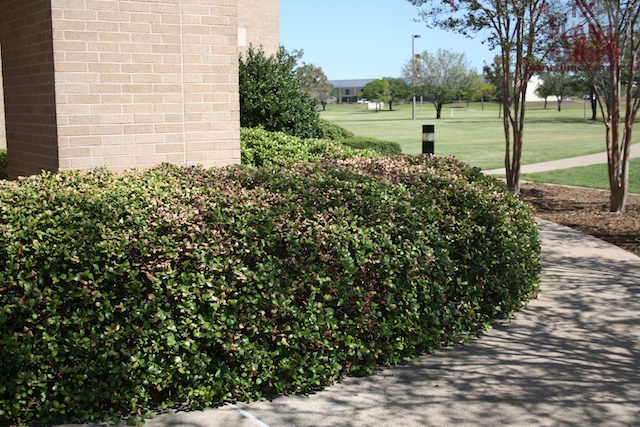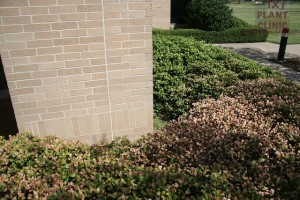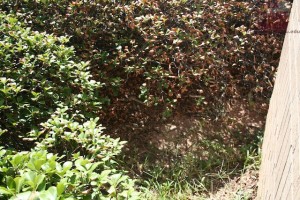This has been another week with 100-plus degree (F) days. Well, cooler temperatures (~90s) at the later part of the week seems to have weather forecasters thinking that the string of hot, hot days are over. Nonetheless, with the dry conditions and any potential windy conditions still make many parts of Texas a danger to wildfires. With wildfires in the news and most people knowing what fire can do to plants. I think it would be educational to look at what heat ( not as extreme as a direct fire source) can do to your plants and this damage can be a result of some obvious causes when you realize what you are looking for.
 Just outside the building where the Plant Clinic is located in, there are a bunch of Indian Hawthorn. These are some rather old bushes. I notice the very interesting patterns and thought I share my photos of it. In the photo above, notice that the damage seems to be localized on the tops of these bushes. Why the tops? Please note that there could be several explanations. These are my thoughts – this damage occurred when it was really hot and dry. I should note that this bed is irrigated. When it is hot and dry, transpiration increases. A simplified explanation is that water leaves the plant quicker than the plant can replenish it. Hence parts of the plant that are exposed and farthest away from the roots (source of water) is going to be the most affected.
Just outside the building where the Plant Clinic is located in, there are a bunch of Indian Hawthorn. These are some rather old bushes. I notice the very interesting patterns and thought I share my photos of it. In the photo above, notice that the damage seems to be localized on the tops of these bushes. Why the tops? Please note that there could be several explanations. These are my thoughts – this damage occurred when it was really hot and dry. I should note that this bed is irrigated. When it is hot and dry, transpiration increases. A simplified explanation is that water leaves the plant quicker than the plant can replenish it. Hence parts of the plant that are exposed and farthest away from the roots (source of water) is going to be the most affected.
Then the other two photos that I included shows the damage extending on the side of the plant (on the side that faces the wall/building column). Imagine why there and not the other (exposed) side of the plant? The clue here is that wall faces south. The third photo is taken looking south, the wall on the right of that photo faces east. Radiant heat from the building column can also prolonged increased transpiration even after the sun sets. Furthermore, I am sure that heat itself can damage the plant. It is possible that the heat (reflected and radiant) alone can damage the leaves. Also notice that the part of the bush on the south facing side is more damaged that the one on the east facing side. The reduced damage of the bushes that abuts the east side of the building column suggest that some of the damage can be attributed to reflected heat of the south facing side.
So the lesson this week is: When you see funky scorching or evidence of drought like symptoms – look around the affected plant to see if anything in the vicinity is contributing the the patterns of damage that is observed. Damage cause by abiotic factors such as environmental extremes are traumatic to the plant and usually result in some uniform and distinct symptom patterns.




